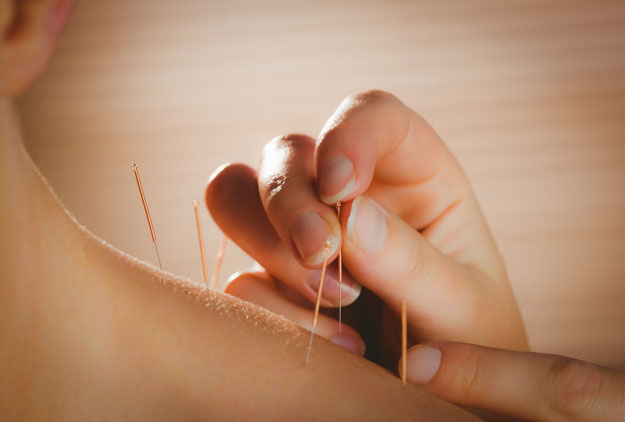Acupuncture and moxibustion alleviate neck pain. Researchers from Xinjiang Medical University Hospital find acupuncture combined with moxibustion delivers consistent positive clinical outcomes for patients with cervical spondylosis, a degenerative disease of the spine. Acupuncture, as a standalone therapy, produced an 83.33% total effective rate. However, adding moxibustion increased the total effective rate to 96.67%.
Cervical spondylosis is a type of osteoarthritis of the neck involving the facet joints and intervertebral discs. Lack of proper biomechanical functioning of the cervical spine over time leads to degeneration of the neck’s bones and protective cartilage. Symptoms range from mild to severe and include pain of the neck and shoulders, stiff neck, muscle weakness, dizziness, and numbness.
The Xinjiang Medical University Hospital researchers document that acupuncture plus moxibustion significantly reduces pain and numbness of the shoulders and neck. In addition, acupuncture plus moxibustion demonstrated clinical efficacy in the restoration of muscle strength. Patients in the study received acupuncture plus moxibustion at a rate of once per day, five times per week for two weeks. The following primary acupuncture points were applied:
Fengchi, GB20
Dazhui, DU14
Tianzhu, ST25
Houxi, SI3
Jiaji, cervical acupoints
Shenshu, BL23
Mingmen, DU4
Additional acupoints were added based on specific indications. The following acupoints were added when the intensity level was severe:
Neck & shoulder pain: Jianjing (GB21), Tianzong (SI11)
Arm & finger numbness: Quchi (LI11), Hegu (LI4), Waiguan (SJ5)
Dizziness & headache: Baihui (DU20), Taiyang (extra)

Mild reinforcing or reducing manual acupuncture techniques were applied. After the arrival of deqi, the acupuncture needles were retained for twenty minutes per acupuncture session. During needle retention, electroacupuncture stimulation was added to the acupoints using a dense-disperse wave. The intensity was set to patient tolerance levels. One study group received only acupuncture and another group received the above acupuncture treatment plus moxibustion. During needle retention, moxibustion was used to warm DU14 and the Jiaji acupoints.
The researchers concluded that acupuncture plus moxibustion is more effective than only acupuncture. Ye et al. had similar findings. Moxibustion plus acupuncture achieved a 92.05% total effective rate and acupuncture, as a standalone therapy, achieved an 81.48% total effective rate for the treatment of cervical spondylosis. Acupuncture and acupuncture plus moxa significantly reduced pain and numbness of the neck, shoulders, and limbs.
Ye et al. measured the biochemical responses to acupuncture and made important findings. Acupuncture significantly reduced blood levels of tumor necrosis factor-a (TNF-a) and the proinflammatory cytokines interleukin-1 beta (IL1β) and interleukin 6 (IL6) for patients with cervical spondylosis. The following acupoints were administered to the patients in the study:
Jiaji, cervical acupoints
Jianjing, GB21
Fengchi, GB20
Shousanli, LI10
Dazhui, DU14
Yanglingquan, GB34
Feishu, BL13
The work of Chen et al. supports the above findings. Chen et al. studied the effects of body style acupuncture combined with ear acupuncture for the treatment of cervical spondylosis. The results document excellent clinical results for 70% of patients and another 26.67% of patients achieved significant positive patient outcomes.
Chen et al. applied acupuncture every other day for a total of ten acupuncture treatments per patient. Ear acupuncture (auricular acupuncture) needling connected the cervical and thoracic spine acupoint regions of the outer ear using a superficial threading technique. Body style acupoints were stimulated with mild reinforcing and reducing techniques to the following acupoints:
Fengchi, GB20
Hegu, LI4
Jiaji, 2 – 3 cervical on the affected side
All three studies above shared the use of cervical level Jiaji acupoints and GB20. Across the studies, the researchers consistently demonstrate clinical improvements for patients with cervical spondylosis. The work of Ye et al. added measurements of biochemical responses finding significant downregulation of proinflammatory cytokines and TNF-a. There is a growing scientific consensus that acupuncture is an effective treatment modality for the treatment of cervical spondylosis.
References:
Shao P, Xin ZP, Qiu ML et al. (2004). Treatment observation on the usage of electrical acupuncture on Jiaji acupoints to treat CSR. China TCM Orthopedics Magazine. 12 (4): 24 -26.
He ZF, Peng HY & Xu BJ (2008). Treatment observation on the usage of electrical acupuncture and Tiaoci technique to treat CSR. Jilin Chinese Traditional Medicine. 28?(4): 278-279
Ye, Y. X., Xu, L. & Yao, J. (2015). The Clinical Observation on Acupuncture Thermal Moxibustion Combined with Convention Acupuncture in Treatment of Acute Cervical Spondylotic Radiculopathy. Journal of Emergency in Traditional Chinese Medicine. 24(6).
Chen XP, Liang Q & Zhou SM. (2014). Controlled Clinical Studies on Treating Neck Cervical Spondylosis with Combination of Point-to-point Auricular Acupuncture along the Skin and Body Acupuncture. Clinical Journal of Chinese Medicine. 6(36).

![Diseases, Symptoms, tcm, [tcmwindow.com]](/uploadFile/adImg/2015/11/11/f5cbfcc0-4df5-4646-9b9a-f316651a0199.jpg)





